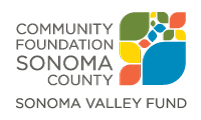A Focus on Youth
Formed at the outset of 2010, the Coordinating Council for Youth Development in Sonoma began its work by assisting grade 4-8 students with activities that enriched their summers. The Council, with the aid of civic organizations, foundations and individuals, enhanced the school district’s newly structured summer school by providing support for study trips, expert guest instructors and teen mentors. It also offered over forty local summer activity scholarships for at-risk students.
We give special thanks to the rotary Club of Sonoma Valley, Exchange Bank, the Scott Raymond Evans Foundation, the Kiwanis Club of Sonoma Plaza and a number of individuals for their commitment to youth in Sonoma Valley, and for ensuring the success of the summer programs.
With continued focus on middle school students, the Youth Initiative’s coordinator recruited expert instructors and implemented diverse enrichment courses for over 300 students in two 2011 after-school sessions. These programs, developed in coordination with the school district’s curriculum, enhance the overall learning experience, with the goal that youth choose to remain in school through graduation and are then ready for college and careers.
Celebrating Community and Volunteerism
Bouverie Preserve of Audubon Canyon Ranch was the spectacular setting for the Sonoma Valley Funds’ annual community celebration. The event attracted more than 200 community members to recognize and honor special volunteers, the 2010 “Sonoma Valley Stars,” selected by SVF’s Partner organizations. This special group of people demonstrates the true spirit of volunteerism in our community.
Assisting Valley Nonprofits Led by Sonoma Valley Fund’s Non Profit Services Initiative committee, a Stanford Business School pro bono Alumni Consulting Team (ACT) recently completed an analysis of 14 Sonoma Valley nonprofit organizations.
The purpose of the study was to determine the feasibility of using pooled purchasing to reduce non-program costs. Through a combination of external research and interviews, the team sought to identify those opportunities with the highest probability for savings. Final recommendations were presented to nonprofit executive directors, board and finance chairs and were based on the potential size of benefit; ease of implementation; and sustainability.
The steering committee and ACT believe that findings could result in significant savings.
Using a conservative prediction of 12% to 17%, combined savings could range from between $265,000 to $375,000. An implementation team continues to work with Sonoma Valley non-profits via the Executive Director, roundtable and other one-on-one assistance, and the results of this initiative will be tracked over the next two years.

